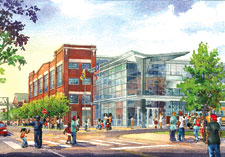...preschool facilities, relocation, costs of temporary and "swing space" construction, not to mention expenses of SCC administration, project management and skyrocketing materials prices, says Ponessa. Building costs now average $200 per sq ft, and up.
Just finding a building site in the densest state in America is hard enough. Add to that a heavy dose of outmoded school buildings and polluted sites, stir in a booming real estate market and you have a recipe for a tough and expensive mission. Newark must acquire sites for 50 of about 70 planned school projects, says the citys facilities management plan. But SCC is leaving almost no tract unturned, and is taking pains to make planned schools live in harmony with municipal and business interests. In some locations, SCC has been able to site schools with mixed-use development, over-school air rights and public-private land exchanges.
Many Abbott districts have embraced schools as community anchors and lures for economic development. The new $26-million West New York Middle School, located in the heavily Hispanic town in teeming Hudson County across from Manhattan, features 173,000 sq ft of well-lighted corridors, 11 science and technology labs and a 600-person auditorium available to the community after school hours. Principal Anthony Ferrainolo accepts kudos from visitors on the facility, just opened in September, as he shows off all the amenities. "The kids have respected what they now have," he says. "Now they have a conducive place for educational development."
 |
 |
| Reuse. Defunct wire factory (above) is set to become a K-8 school, but cost will be high. (Images courtesy of Clarke, Caton Hintz) |
Trenton will adapt the now defunct 94,000-sq-ft Roebling factory, which once produced wire and cable for the Brooklyn Bridge and other spans, for a K-8 school at an estimated $60 million. Planners hope the facility will boost existing ratables and future redevelopment of a site termed "a shadowy abandoned eyesore" in New Jerseys financially struggling capital city.
But others are fighting SCC or are using school plans as political footballs. State education rules often require new or renovated school buildings to be larger in size than old facilities to meet current formulas for appropriate education, officials say. "I dont know any place where a site acquisition problem isnt slowing things down or bringing them to a complete halt," says one industry source. Paul
A. Hamilton, director of SCCs land acquisition division, says his agency and the state Dept. of Environmental Pro-tection now have an agreement to expedite review of old waste sites for new schools.
SCC also is vying with town officials and outside developers who have other ideas for precious land. "A district may pick out a site, but the mayor comes along and wont give up a redevelopment site," says one SCC consultant. The state is "dealing with the pace of the private market and the redirection of growth to developed areas," admits Hamilton. "Sometimes [property owners] are cooperative and sometimes not. SCC doesnt get into bidding wars by virtue of who we are, but in a rising market time is working against us." While the agency can legally condemn sites, it has done so in only about 15 to 20 cases, officials say.
As the new school year proceeds, schoolbuilders, district officials and legislators will be taking a hard look at SCCs ongoing operations and future funding sources. SCC sources say that the early push to move projects out may now be resulting in more change orders and extra cost. The Mechanical Contractors Association of New Jersey has a pending lawsuit against SCC in state superior court, charging that the agency is not enforcing anti-bid shopping rules.
Spencer says SCCs change order proess has been "streamlined" and that the program is still "getting great competition." He cites its small business enterprise rules which earmark 25% of contracts to such firms. The program was made race neutral last year after a court challenge. SCC also launched two initiatives last year to provide small firms with help in securing working capital, bonding and marketing assistance. "We are meeting the goals," says Spencer.
Others say school district unhappiness with "cookbook design" prompted some to push for unique, but costlier, architecture and amenities. Two schools, in Trenton and Perth Amboy, opted for design competitions for new schools. In looking for new efficiencies, SCC will likely be reassessing such designs. Some districts are unhappy about the agencys push for "value engineering," says Ponessa. "They call it cheapening construction."
Now, as stories of SCCs potential funding crunch make headlines across the state, Spencer has a Nov. 22 date to brief state legislators and other officials on the programs official status and financial needs. At a school ribbon-cutting last month, McGreevey said the state "will not be able to bear the entirety of the cost," adding that districts themselves may have to help out.
Ponessa praises SCCs schoolbuild-ing progress to date but says the agency must open its books wider if it hopes to make a case for more funding. Spencer claims his costs are in line with other urban school districts and plans "to do the benchmarking myself." But participants are equally worried that the money woes will generate too much debate and slow construction momentum. "There are a lot of things were excited about," says Ponessa.

Post a comment to this article
Report Abusive Comment